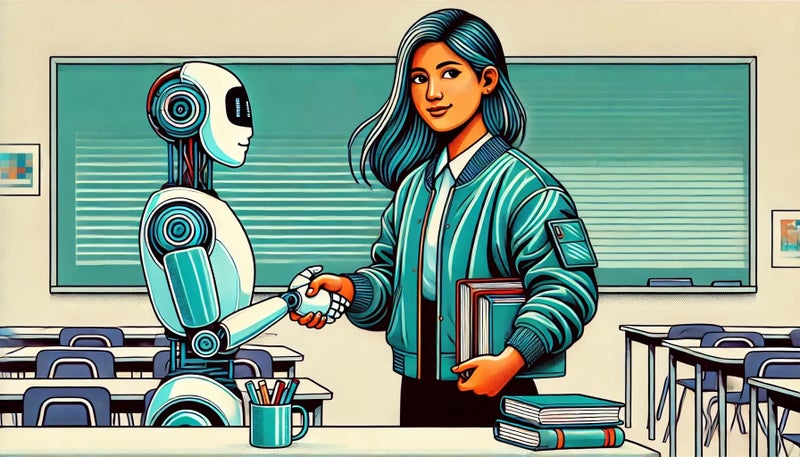Contents
- AI in Education: Why You NEED To Care
- 4 Pros of Artificial Intelligence in Education
- 4 Cons of Artificial Intelligence in Education
- AI in Education Pros and Cons: The Path Forward
What do we know about AI in education? Pros and cons will clarify your judgement. While traditionalists yell outdated fears, students are already using AI with or without your permission. It's time to stop mindlessly debating the inevitable and ACTUALLY address how is AI helpful in education.
The industrial education complex was designed for a world that no longer exists. And it's cracking under its own dead weight.
You're burning out. Your students are checking out. And your administrators are slapping Band-Aids on a system that needs intensive care.
Here's a cold, hard fact: traditional education simply cannot keep up anymore.
The assembly-line approach to learning that worked for the 20th century is failing spectacularly in the 21st.
Teachers have read the room and they're acting decisively:
- Mass Exodus: More than 1 in 3 teachers (37%) plan to wave goodbye to their current school within the next 4 years
- Career Abandonment: 1 in 5 teachers (18%) want to leave teaching behind entirely
- Overwhelm Epidemic: 77% find teaching frequently stressful - with 68% finding it outright overwhelming
- Crisis of Faith: 52% wouldn't advise young people to become teachers today
Evening workathons bleed into weekends. Weekends bleed into burnout. Burnout bleeds into resignation letters.
This isn't sustainable. This isn't necessary. This isn't what education was EVER supposed to be.
Lucky for us, the past doesn't NEED to be the future. And the future of education remains unwritten.
But one thing is absolutely, undeniably, certain: AI WILL be part of education's story.
Students are already using AI tools with or without permission. Teachers embracing AI are cutting their workloads and reclaiming their lives. The resistant few are becoming as obsolete as the outdated system they're clinging to.
Ready to look past the fearmongering and understand the REAL pros and cons of artificial intelligence in education? We're here to answer the question: what about AI in education? Pros and cons like these shed some light on things.
AI in Education: Why You NEED To Care
AI isn't knocking politely at education's door - it's ALREADY redecorating your classroom.
The numbers tell the story:
- Student Adoption: By mid-2024, nearly 50% of K-12 students were leaning on AI chatbots like ChatGPT weekly - a massive 26-point jump from 2023
- Teacher Pioneers: Around 25% of US K-12 teachers are already integrating AI into their planning and teaching
- Workload Relief: 50% of teachers report gen AI tools ease their burden by automating administrative tasks
- Universal Value: Only 1% of educators find absolutely no benefit to using AI
Your students are using AI to decode your lessons, generate study materials, and craft essays that slip past plagiarism detectors. Your colleagues are using it to reclaim hours of their lives WHILE delivering more personalization than ever before.
And it's all happening RIGHT NOW.
The gap between teachers who understand AI and those who don't is becoming THE digital divide in education.
On one side: Teachers working less while delivering more. Weekends spent living. Mental health reclaimed. Joy rediscovered.
On the other: The overworked martyrs, clinging to the past while racing toward burnout, resentment, and ultimately... the exit.
The future waits for no one. Let's dissect the pros and cons of the unstoppable force already transforming your classroom.
4 Pros of Artificial Intelligence in Education
Pro #1: Hyper-Personalization
You see it every day. The quiet desperation in 30 pairs of eyes forced through identical content at identical speeds in identical ways.
Some speed ahead, silently screaming in boredom. Others fall behind, drowning in material they never grasped.
All of them wondering why school feels so... depressing.
It's not your fault. It's the system.
A system that forces you to teach to a fictional average student who doesn't exist in your classroom. Never has. Never will.
But AI offers the first real opportunity for personalized learning paths AT SCALE. No more theoretical differentiation that collapses under real-world constraints. This is technology that dynamically adjusts pacing, style, and delivery for every single student.
Just imagine: Nadia exploring trigonometry two grade levels up, while Noah strengthens the algebra foundations that never quite clicked.
Both moving forward. Both succeeding. Both engaged.
This isn't some distant possibility. It's happening in classrooms TODAY.
Pro #2: Immersive Experiences
Your students live in a world of TikTok dopamine hits and gaming environments designed by psychology experts.
Then they walk into your classroom and face... worksheets.
The gap between their world and school has never been wider. Or more devastating to actual learning processes.
But AI bridges the divide.
VR/AR simulations. Dynamic AI-driven avatars. Intelligent tutor systems that adjust to every individual student in real-time.
AI has brought us into an era where students can live the concepts they learn.
If this sounds too good to be true, it's NOT.
TeachTap by LearnWith.AI already applies cutting-edge AI to bring history's greatest figures back to life. Your students engage with the people who helped build what they're learning, through interfaces they already understand and love.
Just think: Discussing civil rights with MLK. Physics with Isaac Newton. Reading and writing with Jane Austen.
THAT'S a classroom your students get psyched for.
Pro #3: Speed Boosts
The brutal reality of traditional education is it's painfully inefficient.
That one-hour worksheet only needs 25 minutes. That three-day concept only needs one day. Your 180-day school year doesn't need to feel suffocating.
When AI handles the mechanical aspects of learning - repetitive practice, basic knowledge acquisition, foundational skills - time starts to expand.
Suddenly there's space for everything standardization killed:
- Deep and messy critical thinking
- Creative, collaborative problem-solving
- Real-world application that makes learning stick
2 Hour Learning has built an entire model around this simple truth.
Their AI-powered tools help students accomplish in 2 hours what traditionally takes half the school day.
But the grades?
Students leveraging 2 Hour Learning consistently rank in the top 1-2% nationally.
Pro #4: Neurological Engagement
Your students aren't bored because they're lazy. They're bored because traditional education works AGAINST their brain.
Personal relevance is strangled by standardized structures. Immediate feedback is bottle-necked by your packed schedule. Collaboration is cut down to two group projects a year.
But AI doesn't need to work around outdated constraints.
It delivers the speed and flexibility to transform learning into clear, engaging journeys WITH immediate feedback. And it can do it while tapping into the same neurological reward systems that make games so engaging, WITHOUT sacrificing educational substance.
And the transformation isn't subtle.
Students who spent years perfecting their classroom zombie impression suddenly lean forward, engage, debate, and push themselves.
Not because you've threatened or bribed them.
But because learning has become a challenge their brain WANTS to tackle. Rather than an obligation it's forced to endure.
This is education aligned with human neurology. Not warring against it.
4 Cons of Artificial Intelligence in Education
Con #1: The Human Touch Gap
Let's acknowledge the obvious: AI is brilliant at efficiency, but terrible at humanity.
It can't detect the subtle body language that has you checking in. Feel the genuine joy of a struggling student finally breaking through. Build the trust that makes your student give a problem just one more try.
These remain uniquely, powerfully, irreplaceably yours.
But here's where most AI critiques miss the mark: AI isn't meant to replace your humanity. It’s there to create space for it.
When AI handles the mechanical aspects of teaching, your human capacity expands.
You become more present. More connected. More impactful.
And that's exactly the point.
AI frees the human teacher to be more deeply human.
Con #2: Solo Learning Silos
We know the fear.
Thirty students working on thirty different concepts creates thirty isolated islands of learning.
But the reality is far more nuanced.
The traditional classroom offers the illusion of collaboration. But students physically together doesn't mean they're mentally connected.
In fact, forcing 30 students through identical material at identical paces creates HUGE isolation.
Some students silently struggle, too embarrassed to reveal their confusion. Others internally disengage, bored by material they mastered weeks ago.
Let's look at how AI upends this dynamic.
GT School takes an AI-first approach to compress core academics into the morning hours. Then they direct all those saved hours toward deep collaborative experiences.
We're talking project-based learning. Hands-on exploration. Real-world problem-solving.
Their approach doesn't reduce collaboration - it transforms it from performative to purposeful.
From a turn to your partner and discuss charade to authentic intellectual partnership.
Con #3: Data Privacy Landmines
AI runs on data.
Your student's learning patterns, strengths, struggles, and progress feed the algorithms that power their personalized learning paths.
This creates legitimate concerns:
- Who owns this student data?
- How securely is it stored?
- Could it be used in ways that harm students later?
- What are the ethical considerations?
These aren't theoretical worries. They're essential questions that NEED clear answers.
But that's a reason for thoughtful implementation. NOT rejection.
Think of it this way: You wouldn't flat-out refuse to use electricity because improper wiring could cause a fire.
NO! You'd insist on proper safety protocols and make an informed decision.
AI in education requires the same thoughtfulness.
Clear data policies that parents and students understand. Regular security audits with transparent results. Local data storage whenever possible.
The answer isn't avoiding AI to protect privacy. It's implementing AI with privacy as the foundation, not an afterthought.
Con #4: The Perpetual Learning Curve
The statistics should stop you cold:
- 58% of teachers have received ZERO professional development on classroom AI.
- Technical skills have a half-life of just 2.5 years.
The gap between technological acceleration and professional development IS urgent. But it's not an argument against using AI.
It's a wake-up call about what teaching HAS TO become.
The industrial model of education assumed teachers could learn their craft once and apply it for decades with minimal updates. But that era is over.
And in its place emerges a new vision of the educator:
- Perpetual learner
- Adaptive professional
- Technology master
- Continuous innovator
This isn't just another demand on your already overflowing plate. It's a fundamental shift in what it means to be an educator in the digital age.
The question isn't whether you can afford the time to keep learning.
It's whether you can afford not to.
AI in Education Pros and Cons: The Path Forward
Remember that night before your first day teaching?
Heart racing. Mind buzzing. Imagining all the impact that lay ahead.
Then the system swallowed you whole.
Mentorship replaced with lecturing. Creativity crushed under administrative overload. And your students reduced to data points.
This isn't the job you signed up for. And it doesn't need to be your future.
AI can give you back the impact you DREAMED of.
Hyper-personalization for your students. Authentic engagement for you. More impact for everyone.
The new world of AI has empowered educators to BE educators. Not just a suffocating arm of an outdated system.
AI has thrown the door to impact wide open. Are you ready to walk through?
Are you ready to stop debating the AI in education pros and cons and start shaping what comes next? Teachers who embrace AI now aren't just securing their future. They're drawing the path to what teaching was always meant to be.








